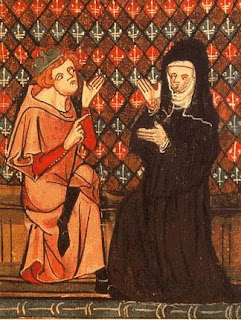Heloise and Abelard: The Power of Love
 |
| Abelard and Heloise from a MS of Romance of the Rose 14th Century |
-Heloise, First Letter to Abelard
TO READ: Mystics, Visionaries & Prophets: Chapter 7, Heloise
OR
Medieval Women Writers:pp. 90-106, Heloise
The twelfth century saw the rise of universities, canon law, a church with sufficient power and influence to rival kings, and a cult of love: love for the Blessed Virgin Mary, and the courtly love of women. However, as our text warns, “Women did not fare well in this century. The romantic and devotional literature of the twelfth century could suggest that women were placed on a pedestal and lived a life of relative comfort and adulation. The opposite was true. Whereas devotional literature emphasized the angelic status of virginity, living women were looked upon as temptresses.” (p. 109)
What does this tell us about a time of rising individuality, and the tension between self and other? If the God of Jesus is a God of love, why was this age so wary of love between humans, stressing instead a culture of abstinence?
The love affair and later marriage of Peter Abelard and Heloise (1090(?)-1164) is one of the best-known in history. Passionate and tragic, it raises questions of the eroticism between professor and student as well as the relationship between earthly and heavenly love. Their carryings on are quite thrilling, and Heloise mentions how, thanks to her lover’s poetry, she was one of the most envied women in Europe. After their marriage and the birth of their son whom she gave to Peter’s sister to raise, Abelard placed Heloise in a convent; this, and not their marriage, stirred the wrath of Heloise’s uncle and guardian and resulted in Abelard’s nocturnal castration.
Read Heloise’s letter to her husband with an open mind and heart. She’s a skilled student of human nature and both faithfulness and faithlessness in love. Although she became Abbess of a convent, she wouldn’t acknowledge God as her first love. Her devotion to Abelard was as complete as La Fresne in Marie de France. Indeed, she suggests that Love is her vocation.
Can you think of a great love affair in our own time?
 |
| The Grave at Pierre Lachaise Cemetery, Paris |
If you want a glimpse into the soul of this time, read the Biblical “Song of Solomon.” Bernard of Clairvaux likened it to the love between Christ and His Church. “What grace! What mighty love!” Bernard writes. “Can it be that the Highest of all is made one with all? Love has brought this about, without regard for its own dignity, strong in affection and efficacious in persuasion. What could be more violent? Love prevails even with God. What could be so nonviolent? It is toward victory, yet is so unresisting to violence? For he emptied himself, so that you might know that it was the fullness of love which was outpoured.” (Sermon 64)
And finally, a love poem attributed to Abelard:
Dull is the Star
Dull is the star once bright with grace
In my heart’s dark cloud.
Faded is the smile from my face,
With no joy endowed.
Justly I grieve,
For though it is near, hidden to me
Is the tender, blossoming tree
To which I cleave.
In love this lovely girl outshines
Every other one.
Her name reflects the beaming lines
Of Helios the Sun.
She is the mirror
Of the sky. In her I rejoice.
She is my life, my only choice,
Now and forever.
I rue the time, each day, each hour,
Of my solitude,
I who nightly pulsed with power,
With such aptitude
For kissing lips
That breathe with spices when they part,
And from which, to bewitch the heart,
Sweet cassia drips.
She wastes away and is without
Hope of nourishment.
Her youth’s flower withers with drought.
May this banishment
In reparation
Be annulled, and be it guaranteed
That life together will success
This separation.
See you on October 3!
Comments
Post a Comment